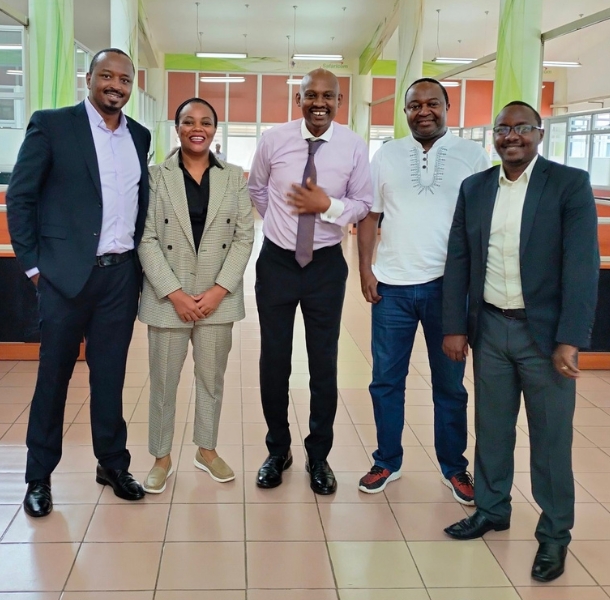
Our History
We are a registry with the sole responsibility of administering, managing and operating the .KE domains in Kenya. In April 1993, the Internet Assigned Number Authority (IANA) delegated the administration of the .KE registry to Dr. Shem K. Ochuodho, while Mr. Randy Bush, took up the technical contact, providing technical and domain name registration for the .KE registry on voluntary basis.
In May 2000, a group of Kenyan Internet Stakeholders and the Kenyan Government launched an initiative to form a participatory, community based non-profit organization located in Kenya to manage both the administrative and technical aspects of the .KE ccTLD registry
We are a registry with the sole responsibility of administering, managing and operating the .KE domains in Kenya. In April 1993, the Internet Assigned Number Authority (IANA) delegated the administration of the .KE registry to Dr. Shem K. Ochuodho, while Mr. Randy Bush, took up the technical contact, providing technical and domain name registration for the .KE registry on voluntary basis.
In May 2000, a group of Kenyan Internet Stakeholders and the Kenyan Government launched an initiative to form a participatory, community based non-profit organization located in Kenya to manage both the administrative and technical aspects of the .KE ccTLD registry
Vision
To be a model Registry and Network Information Centre in Africa by 2030
Our Values
Innovation, Diversity, Excellence and Integrity
Mission
Transform KeNIC into an innovation-driven Organization
Milestones
In July 2015, KeNIC was privileged to host the Africa DNS Forum, at the Sarova Panafric Hotel in Nairobi, under the theme: “The future of Africa’s Domain Name Industry” The Africa DNS Forum is an annual event organized under the Internet Society Africa Regional Bureau’s ccTLD and DNSSEC program. The main objective of the ccTLD and DNSSEC program is to improve the technical and governance operation levels in Africa ccTLD registries. In October 2022, KeNIC again hosted the Africa DNS Forum on 4th – 6th October, 2022 at Emara Ole Serani in Nairobi Kenya. The forum brough together ICT/DNS experts, government representatives, local and international policy makers, global Registries for country code top-level domain (ccTLDs), domain name registrars and registrants to discuss the growth of the DNS Ecosystem and its impact on technology
In 2018, we implemented Domain Name System Security Extensions (DNSEC, we the signed the .KE domain name. We were the third registry in Africa to implement after South Africa and Tanzania.
In 2020, we officially hit 100,000 .KE domain names
Since inception, KeNIC has been on a Third Level Domain space, which allows registration of two-name parts that is, name.co.ke In May 2017, KeNIC launched the second level domain name. The Second Level Domain Name Space allows registration of one name part before the DOT KE with no specialization eg. name.ke. It is a premium and competitive domain name that gives your business aunique and catchy outlook/personality and can be conveniently used alongside the Third Level Domain
KeNIC has had the privilege of hosting other Registries. The objective of these benchmarking exercises was to share marketing campaign tools used to promote Dot Ke (.KE), registry process system which involved creation, renewal, and transfer of domains, trademark processing, various IT Network & support information critical to the daily operations of a registry. The registry that has benchmarked with KeNIC include; tzNIC registry from Tanzania, ART&P from Togo, Ivory Coast Registry, Senegal Registry and the Canadian Registry
In February 2016, more than 50,000 websites with the .KE domain name had their businesses connected globally, quickly and securely following a partnership between KeNIC and the East Africa Data Centre (EADC) in Nairobi. KeNIC, the .KE country code registry moved its server to EADC in a shift that targeted 100% uptime of its service delivery. The project was successful at 99.99%
In 2015: We were privileged to be licensed and issued with the application service provider license and particularly to provide Dot KE domain name registry service by the Communications Authority of Kenya (CA)
Sign up for latest news from KeNIC

Who We Are Today
The core mandate of KeNIC is to manage and administer a secure and reliable .KE domain. Guided by this mandate KeNIC deploys the 3R Model of domain management. We are responsible of licensing Registrars and facilitating them to register, renew and transfer domain name to the end users. This is to create a cost-effective environment for the growth of .KE
The core mandate of KeNIC is to manage and administer a secure and reliable .KE domain. Guided by this mandate KeNIC deploys the 3R Model of domain management. We are responsible of licensing Registrars and facilitating them to register, renew and transfer domain name to the end users. This is to create a cost-effective environment for the growth of .KE
- The Registry: KeNIC as the registry plays the role of managing all dot KE domains
- The Registrar: This is an accredited company or organization that is allowed to sell .ke domain names to the end user. This responsibility of selling the .KE domains is delegated to the registrars by KeNIC, the registry
- The Registrant: This refers to all .KE domain end users including institutions, businesses and individuals
KeNIC Vision For The Future
KeNIC was established with the vision of bringing the Kenyan Internet technology up to global standards and to promote Internet and its services in the country on a large scale. As a registry, our efforts are geared towards ensuring our technological infrastructure supports the efficient administration of the .KE domain and development of the internet ecosystem in Kenya by providing the name service for all .KE
KeNIC was established with the vision of bringing the Kenyan Internet technology up to global standards and to promote Internet and its services in the country on a large scale. As a registry, our efforts are geared towards ensuring our technological infrastructure supports the efficient administration of the .KE domain and development of the internet ecosystem in Kenya by providing the name service for all .KE